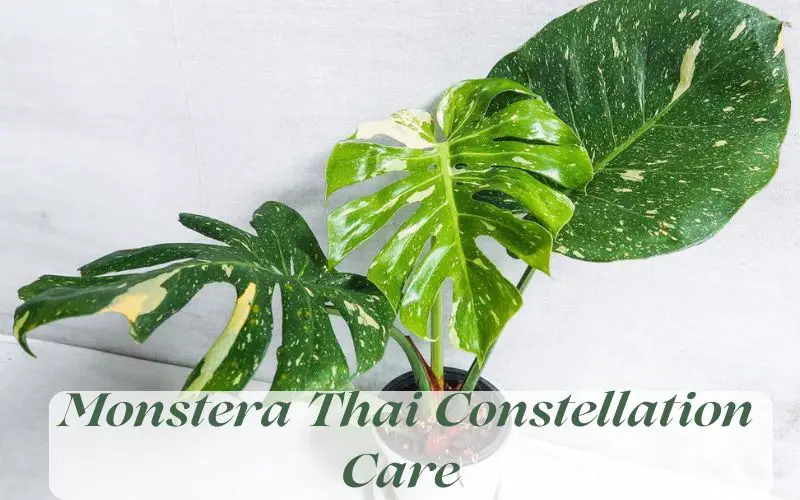You’ve come to the right place! In this blog post, we will discuss everything you need to know about caring for your Thai Constellation Monstera. We’ll go over watering, fertilizing, and pruning tips, as well as how to deal with common problems. So whether you’re a beginner or an experienced gardener, this post has something for you
Monstera Thai Constellation care overview
| Full Size | 8 foot high |
| Light | Bright indirect light |
| Temperature | 64°F − 70°F (18 to 21 degrees Celsius) |
| Humidity | 60% and 80% |
| Soil type | Well-draining soil |
| Color | Green and yellow-to-white variegation |
| Water | Less watering |
| Favorable climate | Tropical |
| Preferable fertilizer | Liquid fertilizer |
| Propagation | Stem cuttings |
| Cost | $$$ |
| Care Level | Medium |
| Toxicity | Toxic |
| Origin | Laboratory in Thailand |
Size
When kept indoors with proper care Your Thai Constellation can grow up to 8 feet (2.5 meters) in length and 3 to 12 inches (7 to 30 centimeters) in width. This plant is quite a slow grower, It may take this plant up to two years to reach full maturity.
Monstera Deliciosa, a faster-growing cousin of this plant, can reach heights of up to 60 feet in the wild. You should provide your plant a moss pole so that it can climb it and develop those bigger leaves.
Thai constellation monstera care with Potting Mix
You should plant Monstera deliciosa ‘Thai Constellation‘ in potting soil that is nutrient-rich and well-draining. Keep the 70/30 ratio in mind at all times. Having said that, use roughly 30% potting soil and 70% free-draining soil. The soil must be kept moist but not drenched or sloppy!
A top-notch indoor potting mix with perlite and bark will significantly enhance drainage. Keep in mind that these plants are prone to root rot, so heavy, compacted soil is definitely not a good idea! Roots need to be dry and free of excess moisture to grow healthily.
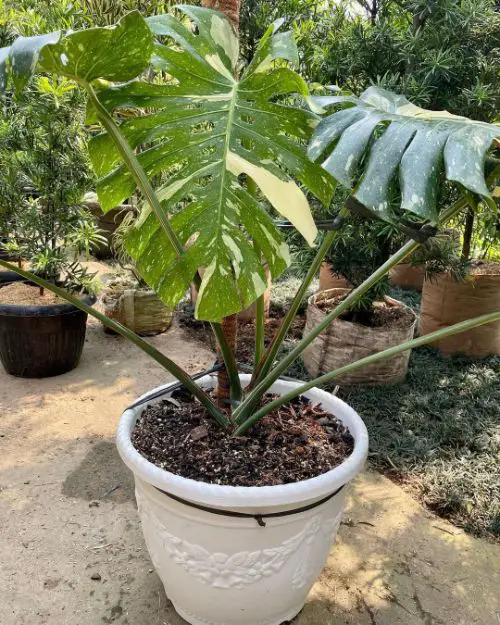
Light Requirements
In order to develop and thrive, Thai Constellation prefers to be placed in bright indirect light. It is not advised to grow Thai Constellation Monstera Deliciosa in low light since its variegation, unlike that of conventional Monstera Deliciosa plants, cannot absorb light. As a result, the plant must work harder to photosynthesize.
Slow growth, leaf discoloration, or adult leaves growing without splits are indications that your Thai Constellation is not receiving enough light. You can keep your plant happy and healthy by moving it to an area with more light. The leaves of your Thai Constellation should not be exposed to direct sunlight as this can harm them.
The addition of a blind or curtain to your window will assist to soften the strong sunlight and prevent scorching the plant’s foliage if it is stored in a location where it receives direct sunlight. If you can’t manage to locate the ideal location in your home, another option is to use grow lights. The foliage of your plant will burn if it is placed too close to the grow lights, just like it would in direct sunlight. Avoid any issues by maintaining a safe gap of at least 60 cm between your plant and the light.
You may also like: How much light does a Monstera need? The Ultimate Guide
Thai constellation monstera care with Temperature
The ideal environment for Thai Constellation growth is one that maintains a temperature of 64–86°F (18–30°C). This plant should be relocated to a warmer location throughout the winter as it cannot handle freezing temperatures. Your Monstera Thai Constellation will stop growing if the temperature falls below 50°F (10°C). Plant health can suffer if it is maintained outside of this temperature range for an extended period of time.
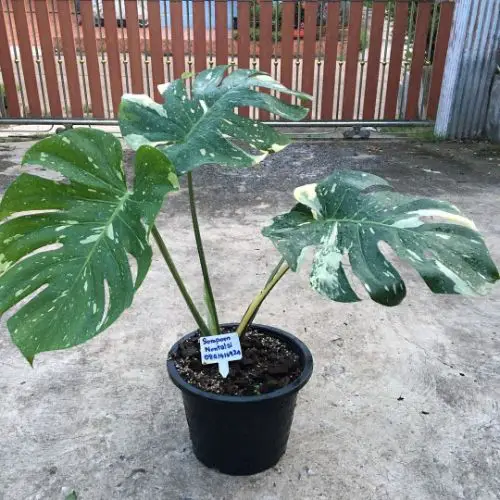
Humidity
Your Thai Constellation will remain happy and healthy if you maintain medium to high humidity (over 60%). They are accustomed to high levels of humidity because they were predominantly raised in a laboratory and closed environment, especially as young plants.
It can result in health problems and damaged leaves if your plant is kept in a location where the humidity level is consistently outside of this range. Browning tips and edges on the leaves are an indication that the air is too dry for your Thai Constellation.
Providing your plants with high humidity will promote larger, healthier development. A few actions you take will help increase the humidity in your house. The options you have are:
- Misting your plants
- Pebble trays
- Assembling plants in groups
- Humidifier
You may also like: Do Monsteras like Humidity? Should I mist the plants?
Watering Needs
Your Thai Constellation should need water at least once every week. This will change when the temperature and amount of sunshine fluctuate during the cooler months. Check the top 2 inches of soil with your finger to see if it still feels moist before watering. You can water your plant if the soil seems dry. Make careful to water your Monstera properly and let the water drain entirely. Weakened leaves are a clue that your Monstera Thai Constellation lacks water.
To avoid leaving your plant sitting in water, ensure all the water has been thoroughly drained. A soil that has received too much water may become soggy and begin to rot the roots. Rotted roots are unable to absorb any nutrients or water for the plant. Your plant may develop fungus problems, dark leaves, pest concerns, and root rot as a result of overwatering. If your Monstera Thai Constellation’s leaves are going pale or yellow, it’s likely that you overwatered it.

Fertilizing requirements
During the growing seasons (Spring/Summer), your Thai Constellation needs fertilizer every month. Use a balanced all-purpose fertilizer that has been diluted to half-strength. You can easily give your plant the nutrition it requires by using liquid indoor plant fertilizers. Your plants receive the vital nutrients they require for fostering and maintaining new, healthy growth when you fertilize them. Salt buildup and root burn can result from fertilizer application when the plant isn’t actively utilizing the nutrients in the soil.
Your Thai Constellation will enter a phase of slow growth or dormancy during the winter months. Since it is not actively encouraging new development during this time, the number of nutrients it needs decreases. Fertilizing shouldn’t be done at this time because it could be harmful to your health. Burnt foliage, withering leaves, and stunted growth are indications that your Monstera Thai Constellation has had too much fertilizer.
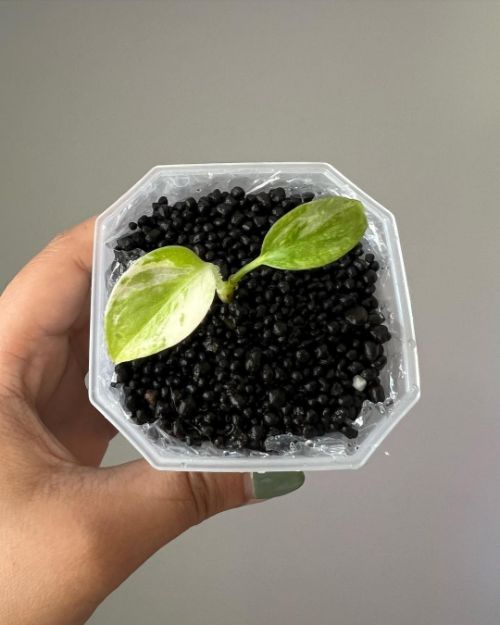
Thai Constellation monstera care with Diseases & Pests
The most frequent pests you may come across while taking care of your Thai Constellation are mealy bugs, scale, thrips, and spider mites. Root rot and fungus problems are the most typical ailments. Keeping a strong, healthy plant is the best defense against the bulk of the pests described because it gives the plant the highest chance of survival and immune system. Click here for further details on how to recognize and deal with common houseplant pests.
When it comes to pests on houseplants, your best course of action is to try to stop any existing pest infestations before they get out of hand. You can do a few things to help prevent bug infestations, including:
- Checking fresh plants for pests or keeping fresh plants in isolation for up to a week.
- Every few days, check your plants for pests.
- Remove any leaves that are dead or withering.
- If you see that the leaves are becoming dusty, wipe them down.
- preserving the health of your plants. A robust plant will be better equipped to withstand an infestation than one that is not as content.
- Pest-infested plants should be isolated.
By doing this, you can help keep pests away and catch them early—before any serious infestations can begin. Pests can be discouraged from infecting your plants by keeping them healthy and in the proper habitats.
Toxicity
Thai Constellation are considered to be toxic to humans and pets if ingested. Consumption of the plant (especially in large quantities) can cause symptoms including; burning of the lips, throat, and mouth, difficulty breathing or swallowing, nausea and vomiting/diarrhea. If these symptoms occur make sure to seek the appropriate medical attention.
Cats and dogs in particular should not be with Thai Constellation Monstera. Intense burning or irritation of the mouth, tongue, or lips, excessive drooling, vomiting, and trouble swallowing are all indications that your pet may have chewed on or consumed a piece of your fruit salad plant.
Also known to cause slight skin irritation is the sap of the Thai Constellation Monstera Deliciosa. Handling fresh clippings is best done while wearing gloves.
How to propagate Monstera Thai Constellation?
If you’re lucky enough to have a Monstera Thai Constellation plant, you may want to propagate it so you can share the love with others! Here’s how to do it:
- Cut a stem from the main plant, making sure to include at least one leaf node.
- Place the stem in water and wait for it to develop roots.
- Once the roots are about an inch long, transfer the stem to a pot with moist soil.
- Water regularly and keep the soil moist, but not soggy.
- Enjoy your new monstera Thai constellation plant!
Related Post: How to propagate Monstera – 1001 tips keeping it healthier
How to repot Monstera Thai constellation
If you’re lucky enough to have a Monstera Thai Constellation plant, you know that they’re pretty finicky when it comes to their potting situation. Here’s a quick guide on how to repot your Monstera Thai Constellation to keep it healthy and happy!
- Start by removing the plant from its current pot. Gently loosen the roots and soil until you can lift the plant out.
- Inspect the roots of your plant. If they’re tightly bound or if the roots are circling the bottom of the pot, it’s time for a repot.
- Choose a new pot that is just slightly larger than the current one. Make sure that the pot has drainage holes to allow excess water to escape.
- Fill the bottom of the new pot with fresh, well-draining potting mix.
- Gently place your Monstera Thai Constellation in the new pot and fill in around the roots with more potting mix.
- Water thoroughly and give your plant a bright spot to call home!
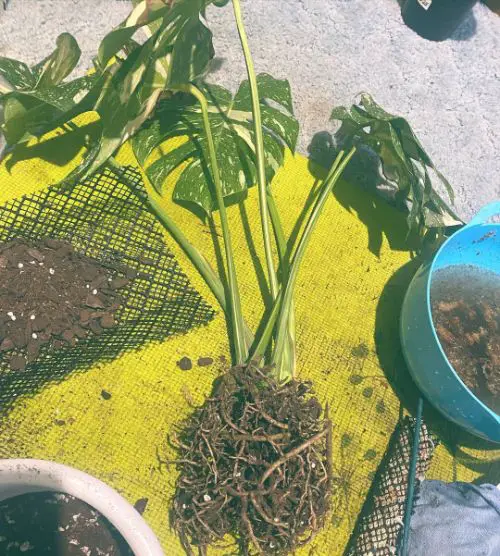
Why is Monstera Thai constellation expensive?
Monstera Thai Constellation is expensive because it is a very rare plant. It is native to Thailand and is not found in many other parts of the world. This makes it a sought-after plant by collectors. Additionally, its large leaves make it a standout amongst other houseplants. All of these factors contribute to its high price tag.
Despite its high cost, Monstera Thai constellation is definitely worth the investment. It is a beautiful plant that will add life to any home. If you are looking for a unique addition to your indoor jungle, this is the plant for you!
How fast does Monstera grow Thai Constellation?
Monstera grows relatively quickly compared to other houseplants. In optimal conditions, it can grow up to 2 feet per year. Monstera does best in bright, indirect light but can also tolerate low-light conditions. Keep the soil moist but not soggy, and fertilize monthly during the growing season. Thai constellation is a variety of monstera that features beautiful, variegated leaves.
Thai constellation grows at the same rate as other monsters, so you can expect it to reach 2 feet in height within 2 years. Like all monsters, Thai constellation does best in bright, indirect light but can also tolerate low-light conditions. Keep the soil moist but not soggy, and fertilize monthly during the growing season.
Monstera Thai Constellation Care Problems
Monstera Thai Constellation care problems can include several different issues that can affect the overall health of your plant. Some of the most common Monstera Thai problems include:
Root Rot
The browning and wilting of stems and foliage are the earliest symptoms of root rot in Monstera Thai Constellation. When there is too much water in the soil and there is inadequate drainage, root rot occurs.
Healthy plants can become quickly damaged by overwatering. The soil must be breathable and quickly drain water. Insufficient oxygen can stunt plant growth and cause root rot. If root rot is not treated, the plant may perish because it weakens the roots as well.
In the worst circumstances, cuttings must be taken in order to grow the plant as a new one. A fungal infection can occasionally affect the roots as well, causing root system destruction.
Save your plant as soon as you notice any yellowing of the leaves. Change the soil, check that the pot has sufficient drainage, and adjust how frequently you water Monstera Thai Constellation to achieve this.
Mealybugs Attack
White, mushy mealybugs can infect Monstera Thai Constellation. This pest, which is solely drawn to the sweet sap, can be found on the plant’s leaves and stem. The mealybugs prefer to be where the greatest sap is found, which is in the joints of vine leaves.
The following signs indicate that Monstera Thai Constellation is mealybug-infected:
- Leaves will be deformed
- The leaves turning yellow.
- dropping leaves
- Growth will be stunned
Isolate the plant right away, then use a powerful water jet to wash the insects away. You might use rubbing alcohol to get rid of the pests if the issue is very serious.
As an alternative, you might sprinkle insecticidal soap on the plant. If applied frequently, it will guard the plant against mealybugs in the future. You can also use neem oil to repel bugs.
Spider Mites Attack
Attacks from spider mites are another issue that might damage Monstera Thai Constellation. If ignored, it may develop into a significant issue. Although the insect is difficult to find, its white web might show that it is hurting plant growth.
On occasion, it resembles a dusty web or different patterns and blemishes on the leaves. Attacks by spider mites are a symptom that the growing environment is hot and dry. Give Monstera Thai Constellation a humid environment. It will support a healthy environment and guard against insect and spider infestations.
Thrips Invasion
The Monstera Thai Constellation is also prone to thrips, which are minuscule white insects. They like feasting on the plants’ tasty sap as well. Thrips may result in dark foliage, discolored leaves, and parched stems.
You can prune them when the invasion first starts and only a few leaves are affected. Neem oil spray is used to treat serious infections. It is preferable to isolate your plants until the issue is resolved if moving them is simple for you.
Scales Attack
Another bug that suckers sap is a scale, which can be challenging to identify but is a real pain to get rid of. You can see yellow leaves and early leaf wilting if the plant is densely covered in scales.
On the leaves, scales also leave behind honeydew, a transparent, glue-like material. Take out the branches and discard them right away. You can spray rubbing alcohol, natural soap, or neem oil on the afflicted foliage.
Salt Buildup
Salt accumulation is another issue with Monstera Thai Constellation. It results in burned leaf tips and leaf tip yellowing.
When there is excessive moisture in the soil, salt starts to accumulate. To avoid this, you can flush the soil with water once a month to get rid of extra salt. The sink space can accommodate small pots. Open the faucet and allow the water to trickle for a bit.
Large outs can be used outside to achieve the same results. In the Monstera Thai Constellation care, this issue can be avoided with good drainage and careful watering.
Tips and Tricks To Grow Thai Constellation Monstera
- Start with a well-draining potting mix. Monstera Thai Constellation does best in soil that is high in organic matter and drains well. Be sure to choose a pot with drainage holes to prevent the roots from sitting in water.
- Place your plant in an area with bright, indirect light. Monstera Thai Constellation will tolerate some direct sun, but too much can scorch the leaves.
- Water your plant when the top 2-3 inches of soil are dry. Monstera Thai Constellation prefers to be on the drier side, so err on the side of underwatering rather than overwatering.
- Fertilize your plant monthly during the growing season with a balanced fertilizer.
- To encourage the growth of its aerial roots, Monstera Thai Constellation will require robust support, such as moss poles.
- Trim the brown portion of the leaf instead of removing the entire leaf if the ends of the leaves start to turn brown.
- It is crucial that you maintain the cleanliness of your leaves. To help the process of photosynthesis, you can wash and dust them.
- To combat insect infestations, regularly clean the leaves of the Monstera Thai Constellation with neem oil.
- Due to their vast root structure, Monstera Thai Constellation prefers deep containers to allow their roots to spread and thrive.
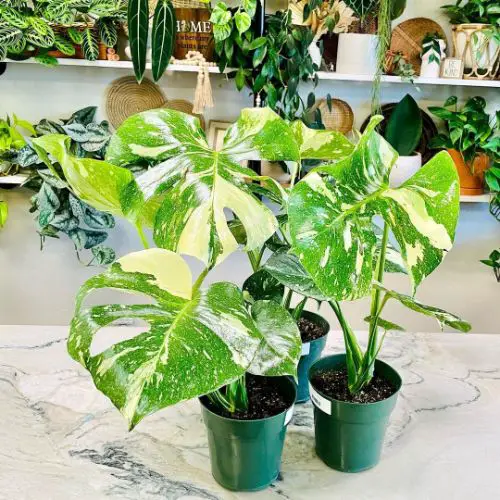
Where to buy Thai Constellation Monstera?
If you’re looking for where to buy Thai Constellation Monster, there are a few places you can check out. One option is online stores such as Amazon or eBay. You can also try plant nurseries or garden centers in your area.
Another possibility is to contact growers or breeders directly. This may be the best option if you’re looking for a specific variety of Thai constellation monstera. You can find growers and breeders by searching online or attending plant shows.
When purchasing Thai constellation monstera, it’s important to consider the plant’s size and needs. Make sure you have enough space for the plant to grow, and that you can provide the proper care. Thai constellation monstera can be finicky, so it’s important to do your research before buying.
Once you’ve found a Thai constellation monstera that you’d like to purchase, it’s important to inspect the plant carefully. Make sure there are no signs of pests or diseases. If the plant looks healthy, go ahead and make your purchase.
Summary
Monstera Thai Constellation is a beautiful, exotic plant that can be a great addition to any home. It’s important to remember, however, that this plant requires some special Monstera Thai Constellation care if you want it to thrive.
In this post, we’ve outlined the size, light requirements, temperature, humidity and watering needs of Monstera Thai constellation as well as the fertilizing and soil requirements. We’ve also discussed some common diseases and pests that can affect this plant and how to deal with them.

